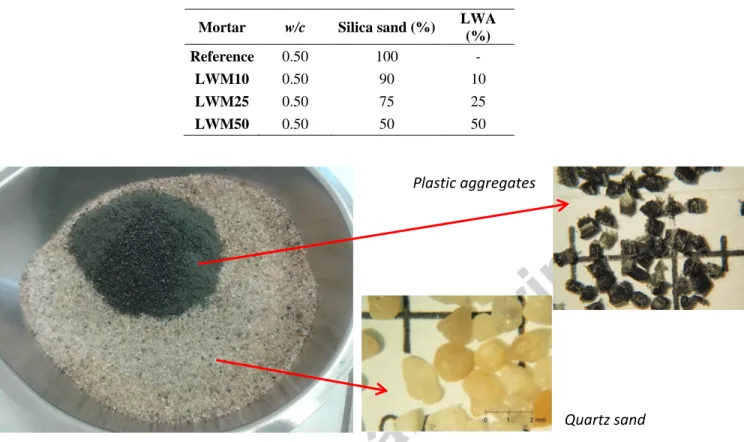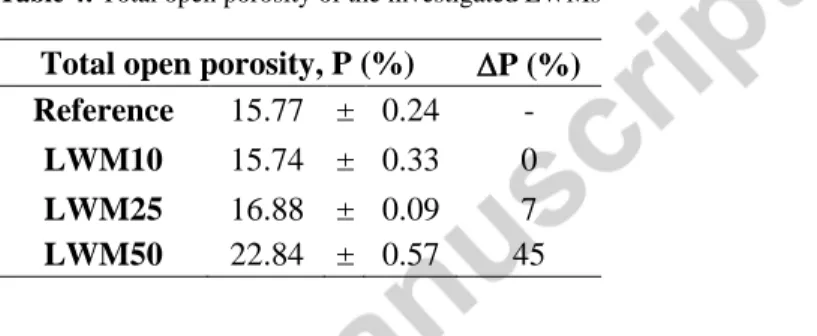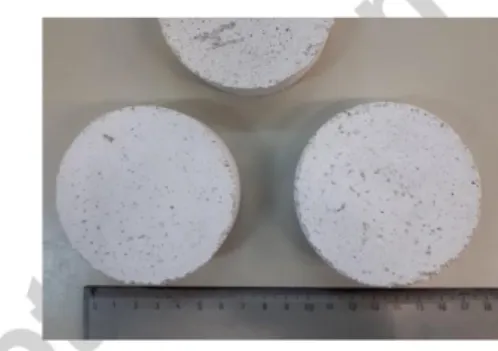Author’s Accepted Manuscript
Data on thermal conductivity, water vapour
permeability and water absorption of a cementitious
mortar containing end-of-waste plastic aggregates
Luciano Di Maio, Bartolomeo Coppola, Luc
Courard, Frédéric Michel, Loredana Incarnato,
Paola Scarfato
PII:
S2352-3409(18)30341-XS0950-0618(18)30573-7
DOI:
https://doi.org/10.1016/j.dib.2018.03.128
Reference:
DIB2391
To appear in:
Data in Brief
Received date: 12 March 2018
Accepted date: 27 March 2018
Cite this article as: Luciano Di Maio, Bartolomeo Coppola, Luc Courard,
Frédéric Michel, Loredana Incarnato and Paola Scarfato, Data on thermal
conductivity, water vapour permeability and water absorption of a cementitious
mortar
containing
end-of-waste
plastic
aggregates,
Data in Brief,
https://doi.org/10.1016/j.dib.2018.03.128
This is a PDF file of an unedited manuscript that has been accepted for
publication. As a service to our customers we are providing this early version of
the manuscript. The manuscript will undergo copyediting, typesetting, and
review of the resulting galley proof before it is published in its final citable form.
Please note that during the production process errors may be discovered which
could affect the content, and all legal disclaimers that apply to the journal pertain.
Data article
Title: Data on thermal conductivity, water vapour permeability and water absorption of a cementitious mortar containing end-of-waste plastic aggregates
Authors: Luciano Di Maio a, Bartolomeo Coppola a b, Luc Courard b, Frédéric Michel b, Loredana Incarnato a, Paola Scarfato a
Affiliations: a University of Salerno, Department of Industrial Engineering, Via Giovanni Paolo II n. 132, 84084 Fisciano (SA), Italy
b
University of Liège, ArGEnCo Department, Quartier Polytech 1, Allée de la découverte 9, B-4000 Liège, Belgium
Contact email: ldimaio@unisa.it
Abstract
The data presented in this article are related to the research article entitled “Hygro-thermal and
durability properties of a lightweight mortar made with foamed plastic waste aggregates”
(Coppola et al., 2018) [
1]. This article focuses the attention on thermal conductivity, water
vapour permeability and water absorption of a lightweight cementitious mortar containing
foamed end-of-waste plastic aggregates, produced via foam extrusion process [
2]. Thermal
conductivity, water vapour permeability and water absorption data are made available to allow
comparison and/or extend the analysis. Experimental investigations showed that the presence of
plastic aggregates decreased thermal conductivity, water vapour resistance and capillary water
absorption.
Specifications Table
Subject area Engineering, Materials Science
More specific subject area Construction and waste materials Type of data Text file, tables, figures
How data was acquired Laboratory balance(OHAUS, Adventurer Pro); digital caliper (MITUTOYO); GHP apparatus (experimental apparatus [10]); environmental chamber.
Data format Raw, analyzed
Experimental factors Mortar samples were prepared according EN 196-1 [3] replacing natural silica sand (particle size distribution 0/2 mm) with three artificial
aggregates volume fractions (10, 25 and 50%). Plastic aggregates were produced according to a procedure described in [2]. Depending on the test, mortar samples were prepared, conditioned and tested according the properly European standard.
Experimental features Data were acquired according different European standards (EN 196-1, EN 12390-7, EN 1015-15, EN 1015-19, EN 12664, EN 12667) [3,5-9]
Data source location Fisciano (SA), Italy, 40°46'18" N, 14°47'40" E; Sart-Tilman, Liège, Belgium, 50°35'28" N, 5°34'16" E Data accessibility Data are within this article
Value of the data
The data indicate the suitability of end-of-waste plastic aggregates for producing a lightweight mortar;
The data can be used as comparison by researchers that are investigating lightweight mortars containing different plastic aggregates;
The provided data can be used for validation or calibration of analytical models;
The experimental data reported a reduced thermal conductivity, water vapour resistance and capillary absorbed water at increasing plastic aggregates content;
Data can be further enriched using other characterization techniques.
Data
In this dataset are listed the results of a study concerning the use of plastic aggregates (prepared according to the procedure described in Ref. 2) into a cementitious mortar. In particular, natural silica sand was replaced at three different volume fractions (10, 25 and 50%) with foamed end-of waste aggregates, as shown in Figure 1 and listed in Table 1. Natural sand replacement with plastic aggregates reduced mortars density, as reported in Table 2.
Moreover, the presence of artificial aggregates influenced also water absorption, water vapour
permeability and thermal conductivity of the investigated mortars. Water absorption results are reported in Table 3 and such results were used to calculate mortars total open porosity (Table 4). In Table 5 are reported the values of the capillary water absorption coefficient, calculated according to EN 1015-18 [6]. Water vapour permeability was measured on cylindrical specimens (Figure 2) according to EN 1015-19 [7]. Water vapour permeability and resistance are reported in Table 6 and Table 7. Thermal conductivity measurements were performed using a GHP apparatus on mortars slab (Figure 3); thermal conductivity of mortar specimens are listed in Table 8.
Experimental Design, Materials and Methods
Materials
Construction and building materials hygro-thermal and durability properties are key parameters in the life and maintenance of structures. The presence of plastic aggregates instead of natural quartz sand modifies mortar microstructure and, consequently, such properties. Table 1 presents the investigated mixtures prepared using an ordinary Portland cement (CEM I 42.5 N), standard quartz sand (0/2 mm) and plastic aggregates replacing natural quartz sand at three volume fractions (10, 25 and 50%). All the samples were prepared using a w/c ratio of 0.50 and sand/cement ratio of 3. Lightweight aggregates (LWAs) and silica sand were dry blended (Figure 1) before the addition to the other mortar constituents (i.e. water and cement). Lightweight aggregates were prepared according the procedure described in [2]. The rough and porous surface of foamed aggregates is able to improve cementitious matrix/plastic aggregates
interactions, which is one of the most important issue in the use of plastic fibers and/or aggregates in cementitious matrices [2,4].
Table 1: Lightweight mortars (LWMs) nomenclature and composition
Mortar w/c Silica sand (%) LWA
(%) Reference 0.50 100 - LWM10 0.50 90 10 LWM25 0.50 75 25 LWM50 0.50 50 50
Figure 1: Plastic and quartz aggregates used in this research Methods
Mortars density was evaluated (three specimens for each composition) according to EN 12390-7 [5]. Table 2 summarizes mortars density and density variation, compared to the reference sample, of the investigated mixtures. As evident, at increasing natural aggregates substitution, a decrease of density was obtained.
Table 2: Dry density of the investigated of the investigated LWMs Dry density, d (g/cm3) d (%)
Reference 2.143 ± 0.012 -
LWM10 1.981 ± 0.003 8
LWM25 1.802 ± 0.008 16
LWM50 1.374 ± 0.013 36
Water absorption (Wab) was determined as the ratio between the amount of absorbed water (difference
between the mass of the saturated and dry specimen) and the mass of the dry mortar specimen. Water absorption and water absorption variation, compared to the reference sample, are reported in Table 3. At increasing artificial aggregates content, an increase of water absorption occurred.
Plastic aggregates
Table 3: Water absorption (Wab) of the investigated LWMs Water absorption, Wab (%) Wab (%) Reference 8.02 ± 0.05 - LWM10 8.83 ± 0.04 10 LWM25 9.60 ± 0.04 20 LWM50 18.74 ± 0.32 134
Total open porosity was calculated considering the ratio between the water absorption and specimen volume. Mortars porosity and porosity variation, compared to the reference sample, are reported in Table 4: at increasing plastic aggregates content, an increase of porosity was obtained.
Table 4: Total open porosity of the investigated LWMs Total open porosity, P (%) P (%)
Reference 15.77 ± 0.24 -
LWM10 15.74 ± 0.33 0
LWM25 16.88 ± 0.09 7
LWM50 22.84 ± 0.57 45
The absorption of water due to the capillary rise was determined on three prismatic specimens for each mixture and the capillary water absorption coefficient (Cw) was calculated according to EN 1015-18 [6]:
eq. 1
where M2 and M1 are the mass of the specimen, in grams, after 90 minutes and 10 minutes of immersion,
respectively.Prior to test, specimens were oven dried up to constant mass at 60 °C. Then, prismatic samples were immersed in deionized water for about 5 mm and the mass variation was measured. The results are reported in Table 5.
Table 5: Capillary water absorption coefficient (Cw) of the investigated LWMs
Capillary water ab. coeff., Cw
[kg/(m2 h0.5)] Cw (%)
Reference 1.87 ± 0.02 -
LWM10 1.26 ± 0.08 32
LWM25 1.02 ± 0.09 45
Water vapour permeability, Wvp, of lightweight mortar samples was determined according EN 1015-19 [7] (Table 6):
eq. 2
where s, A and ΔG are sample thickness, area and mass variation; Δt is the time interval; Δp is the gradient of water vapour tension between saturated solution and samples storing chamber and RA is the resistance
to water vapour diffusion in the air between the sample and the KNO3 saturated solution (0.048⋅109 Pa m2
s/kg, for 10 mm of interspace). Wvp was measured on three flat cylindrical specimens (diameter of 75 mm and thickness of about 20 mm, Figure 2), conditioned at RH = 50 % and T = 20 °C, for each lightweight mortar. Specimens were sealed on glass containers, containing a saturated solution of KNO3, that
provides a relative humidity of 93.2%, at 20°C. The water vapour resistance factor () was measured according to the following equation:
eq. 3
where A is air permeability (1.94⋅10 -10
kg/(Pa m s)) in test conditions (20 °C and 50% RH) and Wvp is water vapour permeability. The results are summerised in Table 7.
Figure 2: Example of cylindrical specimens used for the water vapour permeability test Table 6: Water vapour permeability (Wvp) of the investigated LWMs
Water vapour permeability, Wvp (kg/m s Pa) Wvp (%)
Reference 2.97E-11 ± 1.39E-12 -
LWM10 3.60E-11 ± 1.73E-12 21
LWM25 3.97E-11 ± 1.45E-12 34
Table 7: Water vapour resistance factor (of the investigated LWMs
Water vapour resistance, (%)
Reference 6.56 ± 0.31 -
LWM10 5.72 ± 0.17 13
LWM25 4.90 ± 0.18 25
LWM50 3.38 ± 0.02 48
Thermal conductivity measurements were carried out on mortar specimens of size equal to 30x30x5 cm3 (Figure 3a), manufactured in wood molds. After 28 days of water curing, specimens were conditioned (25 °C and 50 % RH) until constant mass before testing. Five tests were performed for each mortar sample to ensure the reproducibility. Thermal conductivity was measured using the guarded hot plate technique (GHP), defined in the ISO 8302 and specified in European standards EN 12664 [8] and EN 12667 [9]. The device used in this research (Figure 3b) was designed, constructed and validated by Dubois and Lebeau [10].
Figure 3: a) example of specimen used for the thermal conductivity test; b) GHP apparatus Table 8: Thermal conductivity of the investigated LWMs
Thermal conductivity, (W/m K) (%)
Reference 1.408 ± 0.052 -
LWM10 1.365 ± 0.036 -3
LWM25 1.311 ± 0.027 -7
References
1 B. Coppola, L. Courard, F. Michel, L. Incarnato, P. Scarfato, L. Di Maio, Hygro-thermal and durability properties of a lightweight mortar made with foamed plastic waste aggregates, Constr. Build. Mater. (submitted)
2 B. Coppola, L. Courard, F. Michel, L. Incarnato, L. Di Maio, Investigation on the use of foamed plastic waste as natural aggregates replacement in lightweight mortar, Compos. Part B-Eng. 99 (2016) 75. 3 EN 196-1, Methods of testing cement: Determination of strength, 2005.
4 B. Coppola, L. Di Maio, P. Scarfato, L. Incarnato, Use of polypropylene fibers coated with nano-silica particles into a cementitious mortar. In Polymer Processing with Resulting Morphology and Properties: Feet in the Present and Eyes at the Future, Proceedings of the GT70 International Conference, Salerno, Italy, 15–17 October 2015. AIP Publishing: Melville, NY, USA, 2015.
5 EN 12390-7, Testing hardened concrete: Density of hardened concrete. June 2002.
6 EN 1015-18, Methods of test for mortar for masonry. Determination of water absorption coefficient due to capillary action of hardened mortar. December 2002.
7 EN 1015-19, Methods of test for mortar for masonry. Determination of water vapour permeability of hardened rendering and plastering mortars. January 1999.
8 EN 12664, Thermal performance of building materials and products. Determination of thermal resistance by means of guarded hot plate and heat flow meter methods. Dry and moist products of medium and low thermal resistance. March 2001.
9 EN 12667, Thermal performance of building materials and products. Determination of thermal resistance by means of guarded hot plate and heat flow meter methods. Products of high and medium thermal resistance. March 2001.
10 S. Dubois, F. Lebeau, Design, construction and validation of a guarded hot plate apparatus for thermal conductivity measurement of high thickness crop-based specimens, Mater. Struct. 48 (2015) 407.



